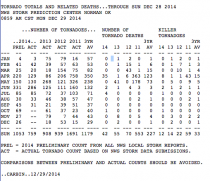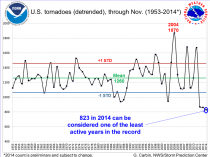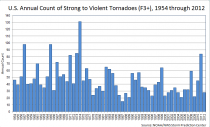Pope Francis evidently has decided to make fighting global warming an important papal cause in 2015. He praised the United Nations’ climate treaty efforts in Lima, Peru; the Vatican has indicated he will issue an encyclical letter to the world’s bishops; he is encouraging the world’s 1.2 billion Catholics to take up the battle against climate change; and he’s planning to address the next UN climate conference in Paris to pressure world leaders to adopt a strong climate agreement.
The Vatican Pontifical Academy of Sciences may be behind the pope’s rising interest in global warming as a moral and political cause. Its chancellor, Bishop Marcelo Sorondo, said, ‘Our academics supported the pope’s initiative to influence next year’s crucial decisions. The idea is to convene a meeting with leaders of the main religions to make all people aware of the state of our climate and the tragedy of social exclusion.”
Many Catholics undoubtedly support the pope’s efforts and, unlike many of his critics, I would argue the views of the pope, a significant moral leader, should be considered as climate policies are shaped. As the leader of the largest Christian denomination in the world, he is charged not just with saving souls but also with alleviating the suffering of the world’s least fortunate, and with leading the Catholic Church in efforts to make the world a better place.
Having said this, I also know moral imperatives and public policies should be grounded in the best-available science, in the reality of the human condition, and in the state of both the planet and the people. Concerning global warming, the pope evidently has been badly misinformed and led astray.
None of the disasters asserted by climate alarmists to result from global warming has come to pass. Hurricane numbers are down, deaths from natural disasters have declined, sea ice is on the rise, and crop production is increasing. Climate models have yet to be validated, missing the lull in temperature rise for the past 18 years and the declining rates of sea-level rise for the past decade. Instead, the gap between temperatures projected by climate models and temperature observed in reality grows yearly.
Investor’s Business Daily has speculated the Vatican is itching to tackle climate change, despite the above-stated facts, because,
[The] Vatican… has been infiltrated by followers of a radical green movement that is, at its core, anti-Christian, anti-people, anti-poor and anti-development. The basic tenets of Catholicism - the sanctity of human life and the value of all souls - are detested by the modern pagan environmentalists who worship the created, but not the creator.... Big Green believes that too many human beings are the basic global problem. People, according to this view, are resource destroyers. Climate change, they say, is due to the overpopulation of Mother Earth.
The pope would do well to question the sources of his information and to recognize his efforts should be focused on alleviating the poverty and suffering of billions of people in the world today. The best policy to accomplish that goal would be alleviating energy poverty worldwide.
As a CNS editorial stated,
Alex Epstein argues, rather than taking a safe climate and making it dangerous through the use of fossil fuels, we have been transforming a dangerous climate into a safer, more manageable one for human flourishing.
Humans have long fought a war with climate, and to the extent we’ve won it has been through the use of technology, most recently including, fossil fuels.
-- H. Sterling Burnett
-------
A review and commentary on topical matters concerning the science, economics, and governance matters associated with climate change developments.
By Alan Moran,
January 2nd, 2015
Happy 2015
New Book on Climate Change
Climate Change: the Facts 2014, a recently published book which I edited and wrote one of the 22 chapters, Costing climate change.
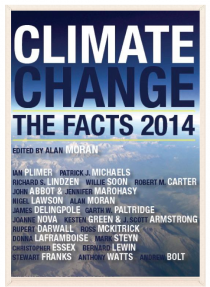
Out Now: Climate Change: the Facts 2014, The following is my introduction:
Prompted by successive reports of the Intergovernmental Panel on Climate Change (IPCC), the issue of human induced climate change has become a dominant theme of world politics. This is especially so in Australia where it was famously called the greatest moral challenge of our time by Kevin Rudd. The issue was pivotal to Mr Rudd’s replacement in 2010 as prime minister by Julia Gillard, his subsequent restoration to that position and his loss to Tony Abbott in the election of 2013.
The book is divided into three parts. Part one examines the science of climate change.
Ian Plimer examines the politics behind the pseudo-science. He notes that many Western governments have a politically popular ideology involving human emission increases in carbon dioxide (CO2) bringing warming, possible catastrophic ‘tipping points’ and a need to phase out fossil fuels as the only means of stopping this. He dismisses the possibility of the catastrophic consequences, drawing from geological history and points to the adverse economic outcomes of attempts to drastically reduce fossil fuel based energy usage.
Patrick Michaels examines the contrast between the predictions of the IPCC and outcomes. And he details and demolishes the manifold excuses for this put forward by Obama adviser, formerly a Club of Rome alarmist, John Holdren, and other IPCC faithful
Richard Lindzen demonstrates that the climate is relatively insensitive to increases in greenhouse gases, and that in any event a warmer world would have a similar variability in weather to that we have always seen.
Part two develops these themes and the chapters explore the politics and economics of climate change.
Nigel Lawson notes that UK Climate Change Secretary Ed Davey and Prince Charles were among those who vilify their opponents with the ‘denier’ label (and recently the UK prime minister sacked climate change sceptic Owen Paterson as secretary for the environment). Lawson explores the dire economic implications of trying to cease the use of fossil fuels. He also demonstrates the trivial effects of the warming that is predicted and discounts their claimed negative effects, noting that scientific developments mean we are far less hostage to climate shifts than in previous eras.
My own chapter (Alan Moran) sets the context of the debate by examining the costs of taking action (which are considerable and massively understated by the IPCC) and any benefits of doing so (which are slender and overstated by the IPCC). And the chapter notes that any gains rely on the unlikely event of a comprehensive international agreement.
James Delingpole notes how the climate believers so often accuse sceptics of lack of credentials. He delves into the qualifications of the major promoters of the climate scare in the UK and Australia and finds wall-to-wall English Literature graduates. When confronted by genuine scientists who dissent from their own view, they invariably suggest the dissenting opinions are dictated by bribes from Big Oil. And yet it is so often vested interests, like Munich Re, that promote the notion of dangerous climate change. The BBC’s denial of platforms to sceptical scientists and the hounding of the eminent Professor Bengtsson from Lord Lawson’s Global Warming Foundation illustrate the lengths the establishment will go to close down debate.
Garth Paltridge recaps the issues confronting meteorologists in 1970 when they first contemplated climate forecasting: clouds, solar balance, oceanic behaviour. He notes we have hardly advanced but that the IPCC tables inaccurate reports which receive little questioning from scientists even though scepticism is supposedly central to science raising any objections. And, as Climategate showed, some scientists have crossed the boundary into “post modern science”. He sees considerable backlash on the credibility of all scientists should global warming fail to eventuate.
Jo Nova points out that, globally, renewables investment reached $359 billion annually while the EU says it will allocate twenty per cent of its budget to climate related spending. All this is based on a naive modelling of the atmosphere that employs amplifications of water vapour’s influence by enhanced levels of carbon dioxide. She estimates money dedicated to promoting the global warming scare is maybe one hundred fold the funding to sceptics. She shows how the purveyors of human-induced global warming use their funding to denigrate opponents and to hide contrary evidence.
Kesten Green and Scott Armstrong test the predictive validity of the global warming hypothesis and find it wanting. They point out that many other alarms have been raised over the past 200 years, none of which have proved to have substance. Most of the alarms that led governments into taking actions actually created harm and none provided benefits.
Part three explores the climate change movement, and the development of the international institutional framework and the growing disconnect from science and scientific observation that characterises the public debate.
Rupert Darwall reviews the farce of the 2009 Copenhagen conference and the subsequent mini-conferences. He notes the veto imposed on costly actions by the increasingly important third world nations, contrasting this with the revolutionary outcome that the IPCC operatives are planning to emerge from Paris in 2015.
Ross McKitrick addresses the trials he and Steve McIntyre went through in puncturing the newly coined late twentieth century myth that temperatures are now higher than at any time in the past millennium. Having been pilloried for bucking the establishment and undermining the IPCC poster-child ‘hockey stick’ graph, the accuracy of their analysis has finally prevailed.
Donna Laframboise notes the scandalous attribution of Nobel Prize status to all involved in the IPCC. She traces qualifications of senior and lead authors and finds them often to be activists with no significant credentials.
Mark Steyn’s essay ‘Ship of Fools’ demonstrates how environmental activist, Professor Chris Turney inadvertently parodied Douglas Mawson’s Antarctic expedition. Turney had expected to see a path to the Pole cleared for his ship by global warming. After all, Al Gore had predicted an ice free Arctic by now. Instead, Turney’s Guardian backed expedition had to be rescued from expanding ice. A genuine scientist, as Turney claims to be, should have realised that Antarctic ice is expanding not increasing.
Christopher Essex points to the complexity of the scientific analysis of the climate, which has led to exaggerated claims by pseudo-experts. He suggests a need to whittle down the numbers and listen only to those with demonstrable qualifications but does not underestimate the difficulties of determining who these are.
Bernie Lewin traces the antecedentaries of the current IPCC and how scientists, many of them genuinely seeking to uncover man’s impact on climate, were hijacked by developing country interests and activists into becoming frontmen for a politicised UN agency.
Drawing heavily upon Karl Popper’s theories that scientific material should be subject to constant examination and should be falsifiable, Stewart Franks points to the many phenomena of climate change that the increase in greenhouse gases both failed to predict and fail to explain.
Anthony Watts illustrates the trivial level of temperature rise that has occurred over the past century (with no increase in the past eighteen years). He notes the change in language by alarmists from ‘warming’ to ‘climate change’ in an attempt to substitute extreme climate events for the now non-existent warming trend. His examination of these extreme events- snow, storms, rainfall - shows an absence of evidence to indicate marked change over recent decades.
Andrew Bolt disinters the graveyards of failed forecasts by climate doomers. These include the spectacular forecasts by Tim Flannery that Australian cities would run out of fresh water, by Professor Hough Guldberg that the Barrier Reef would die, by Professor Karoly that the Murray Darling would see increasing drought, by the UK Met Office that warming would resume, and by Ross Garnaut and Al Gore that hurricanes would increase. He considers the warmistas’ monumental failures are finally denting the faith in them by the commentariat and politicians.
The Chapters all make great reading.
The book can be obtained from here
Dear Alan Leshner,
As an AAAS Fellow since 1994, I am appalled by the AAAS’ decision (neither consulting its membership nor the AAAS Fellows) to issue “a BLANKET ENDORSEMENT of ‘Catastrophic Anthropogenic Global Warming’ (CAGW) by this entire Professional Society”.
Any “REAL scientist” (who has <
CAGW has nothing to do with The hypothesis-driven Scientific Method, but instead relies completely on computer-simulation models, and it seems that no one can admit that “prediction by any of these models has been proven (even one time) to be correct”. Yet, more than $20 billion to $30 billion in the U.S. alone has been spent per year since the end of the 1980s...on this bogus science field (to pay for salaries and more research money to “perform further computer simulations"). JUST THINK how much further the health of each American might improve, if this money ($500 billion to $750 billion) could be channeled into true, meaningful basic and clinical scientific research !
In the Science journal, there should be some venue for discourse on this issue...among AAAS Fellows, or all of AAAS, or all scientists of the Western World. If there is no such opportunity, my plans are to resign as an AAAS Fellow and stop subscribing to the Science journal, which unfortunately has become increasingly little more than a political rag these past several years.
Sincerely,
Daniel W Nebert, MD
Professor Emeritus, Dept of Environmental Medicine; Center for Environmental Genetics
Professor Emeritus, Dept of Pediatrics & Molecular Developmental Biology, Division of Human Genetics
University of Cincinnati Medical Center, P.O. Box 670056, Cincinnati OH 45267
Affiliate Faculty, Oregon State University, Corvallis OR 97331
Faculty Consultant, Yale University School of Public Health, New Haven CT 06520
Dear Dan,
BRAVO!
Thanks so much for your efforts on behalf of legitimate science.
The American Association for the Advancement of Science has become a disgrace under its present leadership. It is amazing that they refuse to consult their membership, let alone their most honored members, their Fellows, on matters of great consequence.
It is therefore important for you and the other Fellows of wayward scientific societies to make their objections known. Thank you very much for doing so.
Gordon
Gordon J. Fulks, PhD (Physics)
Corbett, Oregon USA
---------
Keep up the good work, Dan.
I let my membership in AAAS lapse some years ago when the likes of Holdren, Lubchenko and Leshner took over. I suppose they still count me as a fellow. Roger Cohen led an attempt to rewrite the American Physicial Society’s statement on climate a few years ago. The initial effort was crushed with a brutal cynicism any totalitarian state would envy. But perhaps some good will come of it eventually.
In the mean time, much damage has been done to the reputation of science.
Will Happer
Physics, Princeton
------------
CO2 data shows nobody’s dead from a little carbon dioxide
A little CO2 won’t hurt you. A lot of CO2 won’t hurt you. You breathe out 40,000 ppm with every breath. Do you worry about California banning YOU from breathing out?
I want to clarify my comments. I recently wrote that my CO2 meter said I should be dead in San Diego while exhaling. That was a CO2 spoof, folks. I was having some fun, and I’m still quite alive as I write.
But let me be perfectly clear: I really do have a CO2 meter, and it really did squawk when I blew my exhale into it. Because I’m a CO2 engine, just like you.
Real data
What I’m about to say isn’t a spoof. It’s the result of research and discussions with scientists working in the field. For all of you who need the data, I’ll give them in summary, but you go look up the mountain of references, do some research for yourself, even get a meter if you like. You’ll believe the numbers below better if you discover them on your own. And you won’t need to believe me when I say “I told you so.”
The following summarizes levels of CO2 under various conditions:
40,000 ppm: The exhaled breath of normal, healthy people.
8,000 ppm: CO2 standard for submarines
2,500 ppm: CO2 level in a small hot crowded bar in the city
2,000 ppm: The point at which my CO2 meter squawks by playing Fur Elise
1,000 to 2,000 ppm: Historical norms for the earth’s atmosphere over the past 550 million years
1,000 to 2,000 ppm: The level of CO2 at which plant growers like to keep their greenhouses
1,000 ppm: Average level in a lecture hall filled with students
600 ppm: CO2 level in my office with me and my husband in it
490 ppm: CO2 level in my office working alone
399 ppm: Current average outdoor level of CO2 in the air
280 ppm: Pre-industrial levels in the air, on the edge of “CO2 famine” for plants
150 ppm: The point below which most plants die of CO2 starvation
(all of these data vary a little with size of the space, ventilation, wind, and the like)
What does it mean?
There’s a lot more data out there, but this simple list says it all. Carbon dioxide is present in our outside air at about 400 ppm.
A little less than that and our plants start to suffer.
A little more and there’s little effect on people while plants proliferate.
A lot more and there’s still not much effect on people.
Nowhere in the list of numbers do people get dead. Well, except for those submarines that never surface. You get the point.
Above average is a good thing
Above ambient levels of 390 ppm is where plants start to thrive. Remember your science: it says plants take in CO2 and output O2; people take in O2 and output CO2. We’ve got a good thing going with the plants, not to mention that they grow into what we eat. Having more to eat is a good thing in my book...and in the book of the world where so many people still don’t have enough food.
What happens with less?
But the powers that be namely Gov. Schwarzenegger and the AB32 crew want to lower the levels of CO2 in the air. If those regulations succeed, we will have targeted the plants for destruction. Then what will we eat? Each other?
Leave nature alone
Left on its own, nature has seen much higher levels of CO2 in times when human beings weren’t exhaling in numbers or driving cars. How about we leave well enough alone and let nature and people do their own thing. If that means a little more CO2, we can take it and take it well.
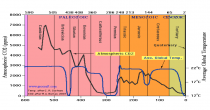
By Boris Konon, Meteorologist and Storm Chaser
Here are the most recent U.S. tornado statistics from the Storm Prediction Center (SPC).
October U.S. tornado count average is 61 (69 preliminary) and November averages is 58 (27 preliminary). Preliminary number for December so far is 29 and average is 24. That essentially appears to be it for the year. The 29 preliminary count this month is about 10 less for a final count when you remove duplicate reports from 12/23. Yearly U.S. average is 1253.
I estimate the final count for 2014 will be ~835. That is an extraordinary deviation from the mean. 67% of average, 6% lower than 2013 and 8% lower than 2012! This is the lowest count since 1988 when 702 tornadoes occurred. 1989 is second with 856.
Here is a graphic that shows “detrended” tornado counts over the years. This helps to account for the better detection and documentation of tornadoes over time. Not perfect, but better than just the raw numbers. Look at 2014...about two standard deviations below average!
In the last 15 years, we see more well below than well above average years. Another way of looking at it, there are more wild swings in the past 15 years. True, but the door swings both ways and unlike say precipitation (too wet or too dry) the lack of tornadoes is a good extreme regardless of how you look at it. So with tornadoes, the more wild swing hypothesis due to climate change cancels things out more or less in the long run. Yes, there will be big years and devastating outbreaks, but that is part of normal climatic variation. As we have seen, for some reason the very occurrence even a single tornado is somehow “unusual” and makes national headlines routinely, even if it hits nothing or does minor damage with no harm to anyone. When about 1250 tornadoes occur in the U.S. a year, a tornado is quite a typical event, not unusual.
Another item, this is the third year in a row where U.S. tornado fatalities have decreased. It is not just regression to the mean either due to the very high toll in 2011. In the last three years, the numbers have been 70, 55, and 46. This has more due to with random chance than climate, as we know all it takes is one badly placed intense tornado to make it a well above average year (i.e.
Joplin), but to level the playing field on an argumentative and prevailing public mindset level, a decrease is a decrease, and that is a good thing. Contrast if it went up 2012-2014, then the klaxons would probably be sounding and this would be utilized as “proof” the weather/climate is getting worse, even though as I said, this is random chance, either way! Mesoscale event placement is so far below mean large scale climate it is basically irrelevant to the issue. Another way of looking at it is that fatalities have resumed the typical in the last 3 years to what has been
occurring in most years going back to 1975.
Two main things at work here,
1) watches/warnings for tornadoes has improved considerably in the last 40 years, and
2) the number of people in this country has increased considerably, from about 216 million in 1975 to 316 million in 2014. So you have one item that decreases the risk of fatalities and one item increasing the risk of fatalities. You can crunch the numbers all you want here, but overall it at worst appears to be status quo in the long term mean.
One more item, although the number of total tornadoes per year is going up overall (and that is more a better detection/documentation fact than anything), the number of F3/EF3+ has shown a slight decrease in trend. These are the ones that do the most damage and cause the most fatalities, and what we should be most concerned with.
Bottom line there is reasonable evidence currently that tornadoes in this country both from a meteorological and fatality point of view are not getting worse. The U.S. represents only 6.6% of the land on the globe, but is the tornado capital of the world, and has a very extensive tornado database, so looking at tornado trends here is better than anything else we currently have to measure
overall activity.



